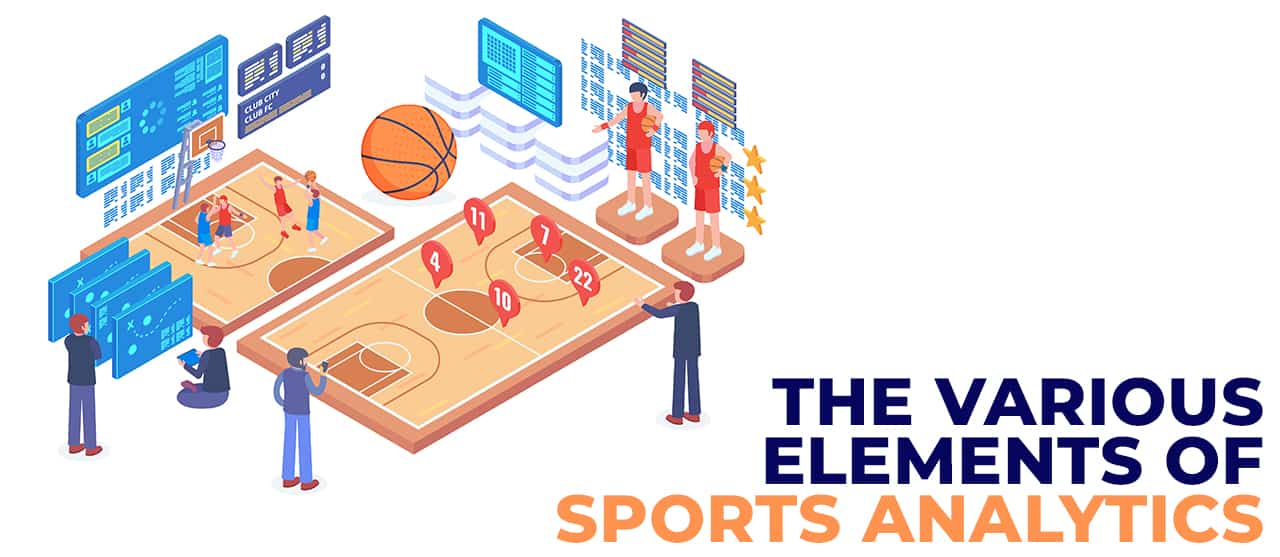
As stated correctly by Dr. Lynn Lashbrook of Sports Management Worldwide, “the frontier of analytics is just beginning, and there is no end in sight to the potential.” As data continues to play a crucial role in practically every industry, it is no surprise that we are seeing the emergence of sports analytics.
With popular sports like soccer, athletics, and tennis being watched by millions across the globe, the worldwide market size for sports analytics is projected to reach $3.44 billion by 2028. Looking at the latest players in this market, the Real Madrid football club is using analytics tools to manage and improve relationships with over 450 million fans.
Effectively, sports analytics is being leveraged for both on-field analytics (for improving player performance & team strategies) and off-field analytics (fan engagement, and merchandise sales). What are the various elements that make sports analytics so effective? It’s time to discuss that.
Five Elements Of Sports Analytics
Sports analytics is all about applying data analytics to sports data including the player’s statistics, team performance, and even match-day weather patterns. To build an efficient sports analytics model, it must comprise the following 5 elements:
1. Data Management
Without high-quality data, it is not possible to have sports analytics. Data management is the first step in the process of capturing, storing, and processing high-quality data. The data management element typically comprises multiple sub-elements including data modeling and information extraction.
2. Data Labeling Or Annotation
Along with data analytics, Artificial Intelligence (AI) technology is increasingly being used in areas like game strategy, audience engagement, and player performance. The driving force behind AI implementation in sports is data labeling or annotation using relevant images and game videos. Image and video annotation are used as essential elements to label sports data accurately for developing AI models.
3. Data Analytics
The data analytics element is all about applying the right analytics to the collected data. This element is typically used to derive future insights for player or game forecasts. For example, wearable technology that can monitor players’ fitness levels is now being deployed to measure key metrics like player’s performance. Real-time data can be extracted for analytics and better decision-making from wearable sensors that are woven into individual players’ jerseys.
4. Information Systems
The use of information systems in sports analytics is essential for extracting and presenting the results efficiently from any data model. Thanks to the global relevance of sports analytics, most information systems are distributed across network clusters or on cloud platforms. Sports analysts skilled in database management and object-oriented programming can leverage the capabilities of information systems to work with relevant sports data.
5. Decision Making
Sports analytics is incomplete without the end goal of using data insights for better decision-making. For sports teams, the decision-makers would typically be the team managers, coaches, or other staff members. Besides that, individual players can also make data-backed decisions about how to improve their game skills or identify any technical faults in their play. Now that we have discussed its various elements, let us look at some of the use cases of sports analytics.
Where Can Sports Analytics Be Used?
As sports management teams rely more upon analytics to make correct predictions and decisions, here are some areas where sports analytics is increasingly being used:
1. Predicting And Managing Player Injuries
Player injuries are a part and parcel of any sports discipline. The use of wearable devices, along with sports analytics, is enabling teams to predict and manage player injuries by measuring metrics like the body mass index (BMI) and their current mechanical load.
With the right data-backed measurements, the team management can identify players with higher injury risk and respond by reducing their exertion levels or by enrolling them in a player conditioning camp to improve their fitness levels.
2. Sports Betting
Sports analytics is also contributing to the growth of the sports betting (or gambling) industry. Sports betting makes up 13% of the overall gambling industry valued at nearly $1000 billion. Legitimate betting companies are investing in analytics tools to improve their probability of winning bets on match outcomes and the performance of “star” players. In-game analytics are using betting algorithms to modify the “odds” of winning based on real-time performance.
3. Player Valuation
Major sports teams are making sizable investments in the top and promising players. Considering the investment, they need to have the relevant player’s data to justify their pay-off. Besides the richer sports teams, even smaller (and upcoming) teams are leveraging sports analytics to invest in the right players. An example of this use case is that of Oakland Athletics manager, Billy Beane, using analytics to build a “winning” baseball team even with a limited budget.
4. Game Strategies
On-field sports analytics are also enabling the improvement of team and player performance and game strategies. Sports managers are using AI algorithms to make decisions based on multiple parameters like weather conditions and the recent win-loss records of the rival team. An example of a successful game strategy is that of the USA Cycling team using real-time analytics to win the Olympic gold medal.
Conclusion
As highlighted in this article, sports teams across disciplines are now leveraging sports analytics to improve their team performance and monitor their player’s fitness levels. This has largely been possible due to the availability of large volumes of data from various games and sporting events. This makes it more important for analytics tools to have access to clean and high-quality data.
As a leading digital service provider, EnFuse Solutions provides services in data tagging and labeling, which makes it feasible for data analytics tools to extract relevant insights from the available data. Are you looking for this type of data-related service for your company? Contact us now.

















Comment